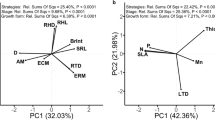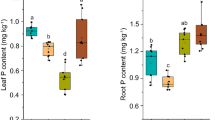Abstract
This study assessed how the palatability of leaves of different age classes (young, intermediate and older) of Eucalyptus nitens seedlings varied with plant nutrient status, based on captive feeding trials with two mammalian herbivores, red-bellied pademelons (Thylogale billardierii), and common brushtail possums (Trichosurus vulpecula). Seedlings were grown under three nutrient treatments (low, medium and high), and we determined how palatability was related to chemical and physical characteristics of the leaves. Pademelons ate more older leaves than young and intermediate leaves for all treatments. This pattern was best explained by sideroxylonals (formylated phloroglucinol compounds known to deter herbivory by other marsupials), and/or essential oil compounds that were present in lower concentrations in older leaves. In the low-nutrient treatment, possums also ate more of the older leaves. However, in the medium- and high-nutrient treatments, possums ate more intermediate leaves than older leaves and showed a behavioural preference for young leaves (consuming younger leaves first) over intermediate and older leaves, in spite of high levels of sideroxylonals and essential oils. The young leaves did, however, have the highest nitrogen concentration of all the leaf age classes. Thus, either sideroxylonals and essential oils provided little or no deterrent to possums, or the deterrent was outweighed by other factors such as high nitrogen. This study indicates that mammalian herbivores show different levels of relative use and damage to leaf age classes at varying levels of plant nutrient status and, therefore, their impact on plant fitness may vary with environment.



Similar content being viewed by others
References
ANKOM (1997) ANKOM200/220 Technology operator’s manual. ANKOM, Macedon, NY, USA
Aranwela N, Sanson G, Read J (1999) Methods of assessing leaf-fracture properties. New Phytol 144:369–393
Behmer ST, Simpson SJ, Raubenheimer D (2002) Herbivore foraging in chemically heterogeneous environments: nutrients and secondary metabolites. Ecology 83:2489–2501
Bryant JP, Kuropat PJ, Reichardt PB, Clausen TP (1991) Controls over the allocation of resources by woody plants to chemical antiherbivore defence. In: Palo RT, Robbins CT (eds) Plant defences against mammalian herbivores. CRC Press, Boca Raton, FL, pp 83–102
Bulinski J, McArthur C (1999) An experimental field study of the effects of mammalian herbivore damage on Eucalyptus nitens seedlings. For Ecol Manage 113:241–249
Choong MF (1996) What makes a leaf tough and how this affects the pattern of Castanopsis fiss leaf consumption by caterpillars. Funct Ecol 10:668–674
Close DC, McArthur C, Paterson S, Fitzgerald H, Walsh A, Kincade T (2003) Photoinhibition: a link between effects of the environment on eucalypt seedling leaf chemistry and herbivory. Ecology 84:2952–2966
Close DC, McArthur C, Hagerman AE, Fitzgerald H (2005) Differential distribution of leaf chemistry in eucalypt seedlings due to variation in whole-plant nutrient availability. Phytochemistry 66:215–221
Coley PD (1983) Herbivory and defensive characteristics of tree species in a lowland tropical forest. Ecol Monogr 53:209–233
Eyles A, Davies NW, Mohammed C (2003) Novel detection of formylated phloroglucinol compounds (FPCs) in the wound wood of Eucalyptus globulus and E. nitens. J Chem Ecol 29:881–898
Freeland WJ, Winter JW (1975) Evolutionary consequences of eating: Trichosurus vulpecula (Marsupialia) and the genus Eucalyptus. J Chem Ecol 1:439–455
Graham HD (1992) Stabilization of the Prussian blue color in the determination of polyphenols. J Agric Food Chem 40:801–805
Hagerman AE (1995) Tannin analysis, 2nd edn. Miami University Press, Oxford, OH
Hanley ME (1998) Seedling herbivory, community composition and plant life history traits. Perspect Plant Ecol Evol Syst 1:191–205
Harper JL (1989) The value of a leaf. Oecologia 80:53–58
Honeysett JL, Beadle CL, Turnbell CRA (1992) Evapotranspiration and growth of two contrasting species of eucalypts under non-limiting and limiting water availability. For Ecol Manage 50:203–216
Iddles TL, Read J, Sanson GD (2003) The potential contribution of biomechanical properties to anti-herbivore defence in seedlings of six Australian rainforest trees. Aust J Bot 51:119–128
Jordan GJ, Dillon RA, Weston PH (2005) Solar radiation as a factor in the evolution of scleromorphic leaf anatomy in the Proteaceae. Am J Bot 92:789–796
Laitinen M-L, Julkunen-Tiitto R, Rousi M (2002) Foliar phenolic composition of European white birch during bud unfolding and leaf development. Physiol Plant 114:450–460
Lambdon PW, Hassall M (2005) How should toxic secondary metabolites be distributed between the leaves of a fast-growing plant to minimize the impact of herbivory? Funct Ecol 19:299–305
Lawler IR, Foley WJ (1999) Swamp wallabies and Tasmanian pademelons show intraspecific preferences for foliage. Aust For 62:17–20
Lawler IR, Stapley J, Foley WJ, Eschler BM (1999) Ecological example of conditioned flavor aversion in plant-herbivore interactions: effect of terpenes of Eucalyptus leaves on feeding by common ringtail and brushtail possums. J Chem Ecol 25:401–415
Lawler IR, Foley WJ, Eschler BM (2000) Foliar concentration of a single toxin creates habitat patchiness for a marsupial folivore. Ecology 81:1327–1338
Lowman MD, Box JD (1983) Variation in leaf toughness and phenolic content among five species of Australian rain forest trees. Aust J Ecol 8:17–25
Lowther JR (1980) Use of a single sulphuric acid–hydrogen peroxide digest for the analysis of Pinus radiata needles. Commun Soil Sci Plant Anal 11:178–188
Maron JL (1997) Interspecific competition and insect herbivory reduce bush lupine (Lupinus arboreus) seedling survival. Oecologia 110:284–290
Marsh KJ, Foley WJ, Cowling A, Wallis IR (2003a) Differential susceptibility to Eucalyptus secondary compounds explains feeding by the common ringtail (Pseudocheirus peregrinus) and common brush tail possum (Trichosurus vulpecula). J Comp Physiol B 173:69–78
Marsh KJ, Wallis IR, Foley WJ (2003b) The effect of inactivating tannins on the intake of Eucalyptus foliage by a specialist Eucalyptus folivore (Pseudocheirus peregrinus) and a generalist herbivore (Trichosurus vulpecula). Aust J Zool 51:31–42
McArthur C, Goodwin A, Turner S (2000) Preferences, selection and damage to seedlings under changing availability by two marsupial herbivores. For Ecol Manage 139:157–173
McArthur C et al. (2003) Nursery conditions affect seedling chemistry, morphology and herbivore preferences for Eucalyptus nitens. For Ecol Manage 176:585–594
McKey DD (1979) The distribution of secondary compounds within plants. In: Rosenthal GA, Janzen DH (eds) Herbivores: their interactions with secondary plant metabolites. Academic, New York, pp 55–133
Neilsen W, Pataczek W (1991) Effect of simulated browsing on survival and growth of Eucalyptus nitens and E. regnans seedlings. Tasforests 3:41–46
Nichols-Orians CM, Schultz JC (1990) Interactions among leaf toughness, chemistry, and harvesting by attine ants. Ecol Entomol 15:311–320
Ohmart CP, Edwards PB (1991) Insect herbivory on Eucalyptus. Annu Rev Entomol 36:637–657
O’Reilly-Wapstra J, McArthur C, Potts BM (2004) Linking plant genotype, plant defensive chemistry and mammal browsing in Eucalyptus species. Funct Ecol 18:677–684
O’Reilly-Wapstra J, Potts BM, McArthur C, Davies NW (2005) Effects of nutrient variability on the genetic-based resistance of Eucalyptus globulus to a mammalian herbivore and on plant defensive chemistry. Oecologia 142:597–605
Pederick LA (1979) Natural variation in shining gum (Eucalyptus nitens). Aust J For Res 9:41–63
Ratkowsky DA, Evans MA, Alldredge JR (1993) Cross-over experiments: design, analysis, and application, 1st edn. Marcel Dekker, New York
Raupp MJ, Denno RF (1983) Leaf age as a predictor of herbivore distribution and abundance. In: Denno RF, McClure MS (eds) Variable plants and herbivores in natural and managed systems. Academic, London, pp 91–124
Read J, Gras E, Sanson GD, Clissold F, Brunt C (2003) Does chemical defence decline more in developing leaves that become strong and tough at maturity? Aust J Bot 51:489–496
Rousi M, Tahvanainen J, Henttonen H, Uotila I (1993) Effects of shading and fertilization on resistance of winter-dormant birch (Betula pendula) to voles and hares. Ecology 74:30–38
Sanson GD (1989) Morphological adaptations of teeth to diets and feeding in the Macropodoidea. In: Hume I (ed) Kangaroos, wallabies and rat-kangaroos. Surrey Beatty & Sons, Sydney, pp 151–168
Sanson GD, Read J, Aranwela N, Clissold F, Peeters P (2001) Measurement of leaf biomechanical properties in studies of herbivory: opportunities, problems and procedures. Aust Ecol 26:535–546
SAS Institute Inc. (2003) SAS/STAT user’s guide, version 9.1. SAS Institute, Cary, NC
Sprent J, McArthur C (2002) Diet and diet selection of two species in the macropodid browser-grazer continuum—do they eat what they “should”? Aust J Zool 50:183–192
Steinbauer MJ, Clarke AR, Madden JL (1998) Oviposition preference of a Eucalyptus herbivore and the importance of leaf age on interspecific host choice. Ecol Entomol 23:201–206
Tabachnick BG, Fidell LS (1989) Using multivariate statistics, 2nd edn. Harper Collins, New York
Volker PW, Orme RK (1988) Provenance trials of Eucalyptus globulus and related species in Tasmania. Aust For 51:257–265
Wallis IR, Herlt AJ, Eschler BM, Takasaki M, Foley WJ (2003) Quantification of sideroxylonals in Eucalyptus foliage by high-performance liquid chromatography. Phytochem Anal 14:360–365
Wang J, Provenza D (1997) Dynamics of preferences by sheep offered foods varying in flavours, nutrients, and a toxin. J Chem Ecol 23:275–288
Watkinson AR (1997) Plant population dynamics. In: Crawley MJ (ed) Plant ecology. Blackwell, Oxford, pp 359–400
Wiggins NL, McArthur C, McLean S, Boyle R (2003) Effects of two plant secondary metabolites, cineole and gallic acid, on nightly feeding patterns of the common brushtail possums. J Chem Ecol 29:1447–1464
Wiggins NL, Marsh KJ, Wallis IR, Foley WJ, McArthur C (2006) Sideroxylonal in Eucalyptus foliage influences foraging behaviour of an arboreal folivore. Oecologia 147:272–279
Wilkinson GR, Neilsen WA (1995) Implications of early browsing damage on the long term productivity of eucalypt forests. For Ecol Manage 74:117–124
Zangerl AR, Bazzaz FA (1992) Theory and pattern in plant defense allocation. In: Fritz RS, Simms EL (eds) Plant resistance to herbivores and pathogens: ecology, evolution, and genetics. University of Chicago Press, Chicago, IL, pp 363–391
Acknowledgments
Animals were caught and maintained under the University of Tasmania Animal Ethics Committee, Project No. A6655; and Parks and Wildlife Service Permit No. FA03102. We thank Ann Wilkinson and Hugh Fitzgerald for assistance with chemical analyses and two anonymous reviewers for making valuable comments on an earlier version of this manuscript. The CRC for Forestry and ANZ Charitable Trust Australia (Holsworth Wildlife Research Fund) funded this research.
Author information
Authors and Affiliations
Corresponding author
Additional information
Communicated by Julia Koricheva.
Rights and permissions
About this article
Cite this article
Loney, P.E., McArthur, C., Sanson, G.D. et al. How do soil nutrients affect within-plant patterns of herbivory in seedlings of Eucalyptus nitens?. Oecologia 150, 409–420 (2006). https://doi.org/10.1007/s00442-006-0525-x
Received:
Accepted:
Published:
Issue Date:
DOI: https://doi.org/10.1007/s00442-006-0525-x




